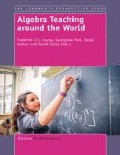Abstract
The didactic triangle in which the student, the teacher and the content (mathematics) form the vertices of a triangle has been a ‘trivium’ (Goodchild and Sriraman, 2012) used to conceptualize teaching and learning in the mathematics classroom (National Research Council, 2001). Under this conceptualization, the didactic relationship is a ternary one among the student, the teacher, and the pieces of knowledge at stake (Sensevy, et al, 2005).
Access this chapter
Tax calculation will be finalised at checkout
Purchases are for personal use only
Preview
Unable to display preview. Download preview PDF.
References
Clarke, D. J. (1998). Studying the classroom negotiation of meaning: Complementary accounts methodology. In A. Teppo (Ed.), Qualitative research methods in mathematics education. Journal for Research in Mathematics Education, Monograph No 9 (pp. 98–111). Reston, VA: NCTM.
Clarke, D. J. (Ed.). (2001). Perspectives on practice and meaning in mathematics and science classrooms. Dordrecht: Kluwer Academic Publishers.
Clarke, D. J., Shimizu, Y., & Keitel, C. (2006). Mathematics classrooms in twelve countries: The insider’s perspective. Rotterdam: Sense Publishers.
Francisco, J. M. (2005). Students’ reflections on their learning experiences: lessons from a longitudinal study on the development of mathematical ideas and reasoning. Journal of Mathematical Behavior, 24, 51–71.
Freudenthal, H. (197). Mathematics as an educational task. Dordrecht-Holland: Reidel Publishing Company.
Goodchild, S., & Sriraman, B. (2012). Revisiting the didactic triangle: from the particular to the general. ZDM, 44(5), 581–585.
Goos, J. (2004). Learning mathematics in a classroom community of inquiry. Journal for Research in Mathematics Education, 35(4), 258–291.
Jacobs, J., & Morita, E. (2002). Japanese and American teachers’ evaluations of videotaped mathematics lessons. Journal for Research in Mathematics Education, 33(3), 154–175.
Kang, W., & Kilpatrick, J. (1992). Didactic Transposition in Mathematics Textbooks. For the Learning of Mathematics, 12(1), 2–7.
Mullis, I. V. S., Martin, M. O., Gonzalez, E. J., & Chrostowki, S. J. (2004). TIMSS 2003 International Mathematics Report. International Study Center, Lynch School of Education, Boston College, Boston.
Mullis, I. V. S., Martin, M. O., & Foy, P. (2009). TIMSS 2007 International Mathematics Report. TIMSS & PIRLS International Study Center, Lynch School of Education, Boston College, Boston.
National Research Council. (2001). Adding it up: Helping children learn mathematics. Washington, DC: National Academy Press.
Pirie, S. E. B. (1996). What are the data? An exploration of the use of video-recording as a data gathering tool in the mathematics classroom. Paper presented at the Sixteenth Annual Meeting of the International Group for the Psychology of Mathematics Education, North America, Florida State University, Panama City.
Sensevy, G. Schubauer-Leoni, M., Mercier, A., Ligozat, F., & Perrot, G. (2005). An attempt to model the teacher’s action in the mathematics class. Educational Studies in Mathematics, 59, 153–181.
Shimizu, Y. (2006). Discrepancies in perceptions of mathematics lessons between the teacher and the students in a Japanese classroom. In D. J. Clarke, C. Keitel, Y. Shimizu (Eds.). Mathematics classrooms in twelve countries: The insider’s perspective (pp. 183–194). Rotterdam: Sense Publishers.
Author information
Authors and Affiliations
Editor information
Editors and Affiliations
Rights and permissions
Copyright information
© 2014 Sense Publishers
About this chapter
Cite this chapter
Park, K., Leung, F.K.S. (2014). Eye of the Beholder. In: Leung, F.K.S., Park, K., Holton, D., Clarke, D. (eds) Algebra Teaching around the World. Series Preface. SensePublishers, Rotterdam. https://doi.org/10.1007/978-94-6209-707-0_6
Download citation
DOI: https://doi.org/10.1007/978-94-6209-707-0_6
Publisher Name: SensePublishers, Rotterdam
Online ISBN: 978-94-6209-707-0
eBook Packages: Humanities, Social Sciences and LawEducation (R0)

